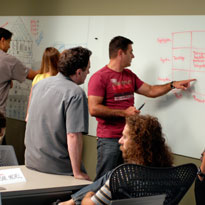Unleashing Engineering Creativity
- Course:Unleashing Engineering Creativity
- Course ID:ENG-CREATE Duration:2 days Where: Your Office (7+ Persons)
- Download Course Description (PDF)
Available as a private, customized course for your group at your offices or ours and in some cases as a WebLive(TM) class.
Course Outline
Day 1: Introductory Concepts and Creativity Enhancement Techniques
- Introduction and Course Overview. Defining creativity. Creativity Stages. Taylor’s hierarchy of creativity. Creativity obstacles, including fear of the unknown, fear of failure, reluctance to exert influence, frustration avoidance, resource myopia, participation reluctance, over-certainty, and structured thinking patterns.
- Brainstorming and Painstorming. Brainstorming approaches. Brainstorming rules. Identifying areas of customer dissatisfaction. Sources of customer product satisfaction information. Examples. Group exercise.
- Synectics. Disciplined idea harvesting. Documenting “I wish” comments. Including customer participation. Funneling ideas into manageable options. Examples. Group exercise.
- Functional Decomposition. Identifying functional requirements. Inputs and outputs. Flowcharting. Identify functional interactions and conflicts. Quality Function Deployment. Making trades. Examples. Group exercise.
- Biomimicry. Definitions. Seeking solutions by emulating nature. Finding appropriate emulation targets. Reducing cost and waste. Examples. Group exercise.
- Axiomatic Design. The independence and information axioms. Matrix methods. Transforming customer needs into products. Examples. Group exercise.
- Ethnography. Definitions and approach explanation. Gathering information by examining cultures. Understanding design impacts on individuals and cultures. Understanding the consumer experience. Examples.Group exercise.
- TRIZ. TRIZ background and development history. The theory of inventive problem solving. Using the TRIZ matrix and the 40 design solutions. Analogical thinking. Examples. Group exercise.
- Lateral Benchmarking. Finding best practices. Looking outside your industry for best practices. Strategies for identifying lateral industries. Not knowing what can’t be done. Examples. Group exercise.
Day 2: Creativity Stimulation Techniques and Application (continued)
- Quality Function Deployment. The house of quality. Identifying, requirements, needs and wants. Prerequisites. The what’s, the how’s, and the how much’es. Benchmarking. The graphical approach. Quantification. Using Excel. Examples. Group exercise.
- Kano Model. Product development and customer satisfaction. The attractive, one-dimensional, must-be, indifferent, and reverse categories. Relationship to quality function deployment. Examples. Group exercise.
- Trimming. Identifying functions, developing approaches for alternative assignment, recipient functional assignment, function elimination, redesigning for improved functionality, and identifying new markets as a result of improved functionality. Examples. Group exercise.
- Nine Windows. The nine windows grid. Considering innovation from the perspectives of time (past, current, future) and space (super-system, system, sub-system). Examples. Group exercise.
- De Bono’s Six Hats. The Six Thinking Hats by Edward De Bono. Information, emotions, bad points judgment, good points judgment, creativity, and meta-thinking. Overcoming our natural tendencies toward black hat thinking. Examples. Group exercise.
- De Bono’s Concept Fans. Discovering alternative solutions. Graphical presentations. Taking steps back to gain a broader perspective. Similarities to mind mapping. Examples. Group exercise.
- Problem Focus. Expressing the right problem. Problem statement and restatement. 5 Why’s. Present state – future state discussion. Checklists. Trigger words. Situation analysis. Examples. Group exercise.
- Bisociation. Blending elements from two fields previously considered unrelated. The comparison, abstraction, categorization, analogies, and metaphors matrix. Concept blending theories. Examples. Group exercise.
- Course Wrap-Up. Course review. Questions and answers. Plans for future actions. Course critique.
Course in a Nutshell
This workshop explores the best techniques for stimulating thinking, creating new products or services, and solving design challenges. Many organizations and engineers rely on brainstorming, but this simplistic approach often fails to stimulate creativity in a meaningful way. Unleashing Engineering Creativity goes far beyond brainstorming. It explores state-of-the-art creativity stimulation approaches and provides recommendations for overcoming self-imposed obstacles. It’s an intense two-day workshop that will help your organization realize significant creativity improvements. It includes lectures, interactive discussion, examples, and group exercises to assure thorough comprehension and comfort levels with these exciting creativity enhancement approaches.
Customize It!
Whatever the nature of your systems, products/services, and objectives, we will customize the course to meet your specific needs and concerns. Here are some of the ways in which we can tailor the course to help you get more out of it:
- Additional “workshop days” to allow participants to work together to address creativity enhancement topics specific to your organization. The workshop day can be scheduled a few weeks after the course to allow time for applying the technologies presented in class under an experienced engineer.
- Schedule post-class follow-up consultation for continuing your in-house creativity stimulation implementation.
Learn How To
- Work together to understand/implement creativity stimulation concepts and techniques.
Aimed At
This course is aimed at engineers, designers, business strategists, business development specialists, and others charged with creating innovative products or services as well as those who work with them or manage their work.
Prerequisites
While there are no formal prerequisites, the course assumes a design, engineering development, or business development background.
- “Instructor outstanding; knowledgeable, keeps interest and class fun. Liked the variety of tools presented for unleashing creativity.” – Sean, Manager D&D, Fortune 500 Technology Company
- “Liked immediate practice group activities on each technique just after its presentation. Very comprehensive; many good, practical examples to illustrate broader principles. Instructor extremely knowledgeable, knows how to present, and keeps a good pace. Very good, helpful materials.” – Tom Goldblatt, Manager Custom products, Zebra Technologies

